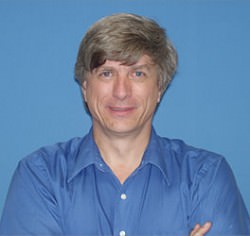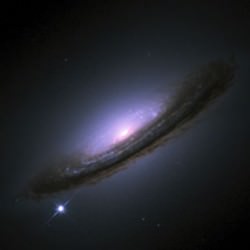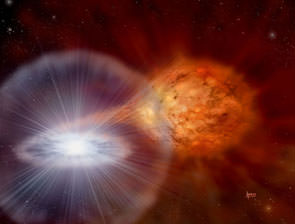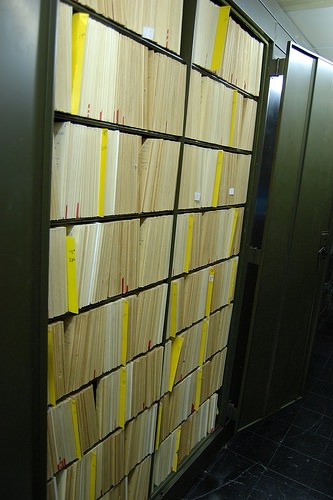[/caption]
Just as psychologists and detectives try to “profile” serial killers and other criminals, astronomers are trying to determine what type of star system will explode as a supernova. While criminals can sometimes be caught or rehabilitated before they do the crime, supernovae, well, there’s no stopping them. But there’s the potential of learning a great deal in both astronomy and cosmology by theorizing about potential stellar explosions. At the American Astronomical Society meeting last week, Professor Bradley E. Schaefer of Louisiana State University, Baton Rouge, discussed how searching through old astronomical archives can produce unique and front-line science about supernovae – as well as providing information about dark energy — in ways that no combination of modern telescopes can provide. Additionally, Schaefer said amateur astronomers can help in the search, too.
Schaefer has been studying archived data back to 1890. “Archival data is the only way to see the long-term behavior of stars, unless you want to keep watch nightly for the next century, and this is central to many front-line astronomy questions,” he said.

The main question Schaefer is trying answer is what stars are progenitors for type Ia supernovae. Astronomers have been trying to track down this mystery for over 40 years.
Type Ia supernovae are remarkably bright but also remarkably uniform in their brightness, and therefore are regarded as the best astronomical “standard candles” for measurement across cosmological distances. Type Ia supernovae are also key to the search for dark energy. These blasts have been used as distance markers for measuring how fast the Universe is expanding.
However, a potential problem is that distant supernovae might be different from nearby events, thus confounding the measures. Schaefer said the only way to solve this problem is to identify the type of stars that explode as Type Ia supernovae so that corrections can be calculated. “The upcoming big-money supernova-cosmology programs require the answer to this problem for them to achieve their goal of precision cosmology,” said Schaefer.

Many types of star systems have been proposed as being the potential supernovae, such as double white dwarf binaries which were not discovered until 1988, and symbiotic stars which are very rare. But the most promising progenitor is the recurrent novae (RN) which are usually binary systems with matter flowing off a companion star onto a white dwarf. The matter accumulates onto the white dwarf’s surface until the pressure gets high enough to trigger a thermonuclear reaction (like an H-bomb). RNs can have multiple eruptions every century (as opposed to classical novae which have only one observed eruption).
To answer the question if RN are supernova progenitors, Schaefer conducted extensive research to get RN orbital periods, accretion rates, outburst dates, eruption light curves, and the average magnitudes between outbursts.

One big question was whether there were enough RN occurrences to supply the observed rate of supernovae. Another question was if the nova eruption itself blows off more material than is accumulated between eruptions, so the white dwarf would not be gaining mass.
In looking at the old sky photos, he was able count all the discovered eruptions and measure the frequency of RN eruptions back to 1890. He could also measure the mass ejected during an eruption by measuring eclipse times on the archived photos, and then looking at the change in the orbital period across an eruption.
In doing so, Schaefer was able to answer both questions: There was enough RN occurrences to provide sources for the observed Type Ia supernovae rate. “With 10,000 recurrent novae in our Milky Way, their numbers are high enough to account for all of the Type Ia supernovae,” he said.
He also found the mass of the white dwarf is increasing and its collapse will occur within a million years or so, and cause a Type Ia supernova.
Schaefer concluded that roughly one-third of all ‘classical novae’ are really RNe with two-or-more eruptions in the last century.
With this knowledge, astronomical theorists can now perform the calculations to make subtle corrections in using supernovae to measure the Universe’s expansion, which may help the search for dark energy.
An important result from this archival search is the prediction of a RN that will erupt at any time. An RN named U Scorpii (U Sco) is ready to “blow,” and already a large worldwide collaboration (dubbed ‘USCO2009’) has been formed to make concentrated observations (in x-ray, ultraviolet, optical, and infrared wavelengths) of the upcoming event. This is the first time that a confident prediction has identified which star will go nova and which year it will blow up in.
During this search Schaefer also discovered one new RN (V2487 Oph), six new eruptions, five orbital periods, and two mysterious sudden drops in brightness during eruptions.
Another discovery is that the nova discovery efficiency is “horrifyingly low,” Schaefer said, being typically 4%. That is, only 1-out-of-25 novae are ever spotted. Schaefer said this is an obvious opportunity for amateur astronomers to use digital cameras to monitor the sky and discover all the missing eruptions.

Schaefer used archives from around the world, with the two primary archives being the Harvard College Observatory in Boston, Massachusetts and at the headquarters of the American Association of Variable Star Observers (AAVSO) in Cambridge, Massachusetts. Harvard has a collection of half-a-million old sky photos covering the entire sky with 1000-3000 pictures of each star going back to 1890. The AAVSO is the clearinghouse for countless measures of star brightness by many thousands of amateurs worldwide from 1911 to present.
Source: Louisiana State University, AAS meeting press conference


It would be great if all tose photos and all the variable star data could be put into a searcable digital data base. And what about all the survey photos from all the major observatories.
correction: …if all those photos…
So if there wrong about type la supernova then there wrong about the acceleration of expansion sounds like alot is riding on this one theory..
Prof. Josh Grindlay at Harvard is working to do that exact thing. See, for example, the following NY Times article from July 2007:
http://www.nytimes.com/2007/07/10/science/10astro.html?pagewanted=1&_r=1
They have a state-of-the-art scanner built and ready to go. The only hitch is that it will cost about 3 million dollars for the manpower to physically process the plates through the scanner.
An excellent report. Empirical evidence that all type 1a supernovae are in fact recurring and result from the same mechanism seems almost crucial in retrospect. Very good work.
Kudos again to Brad Schaefer for data mining archival plates for relevant astronomical research. I am well aware of his efforts of using such resources to elucidate and propel research into gamma ray bursters several years back. I’m heartened to see that such data mining is still being actively pursued to help in other areas of astronomical research. I can see much more relevant research being done with digitized archival plates from numerous institutions around the world. Congrats to Brad and his colleagues in exploiting this invaluable database in furtherance of astronomical research.